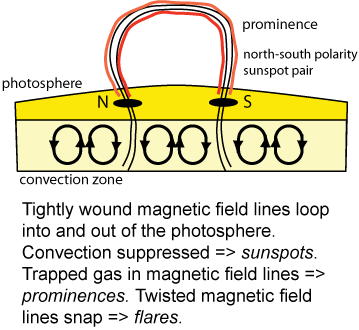The Sun goes through a phase called the solar cycle. This is
a period of 11 years where the quantity of sunspots typically change over the
course of the cycle. At the beginning of
the cycle, the sunspots are few in number, and begin to appear around 40° latitude,
in both the northern and southern hemispheres.
Near the end of the cycle, the number of sunspots reaches a maximum.
Then drops to zero. Then a new cycle begins.

However, at the beginning of the new cycle, something strange
happens. The Sun switches polarities.
The North Magnetic Pole becomes the South Magnetic Pole, and vice versa. This also happens on Earth, but takes much
longer to occur, approximately hundreds of thousands of years. This will be a
topic for future blog post.
The 11-year cycle is the period that describes the quantity
of sunspots and other phenomena of solar activity. The Solar Magnetic Cycle is
the 22-year period where the Sun flips its magnetic poles, then back again.
So, what exactly are sunspots? Sunspots are large blemishes that dot the
surface of the Sun. In a previous blog
post, it was discussed how the Sun does not rotate uniformly, but at different
rates at different latitudes. In the
course of rotation, magnetic field lines on the surface of the sun get “kinked”
and leave the surface of the Sun.
Therefore, a sunspot is a pole of a giant magnet .
And because there does not exist a magnetic monopole (in theory), sunspots will
always come in pairs.


Sunspots appear dark on the surface of the Sun because they
are cooler than the surrounding photosphere. In reality, sunspots are 4500 K*
(7640°F) when the surrounding photosphere is 6000 K (10,340°F).
*Kelvin (K) is the
temperature scale used in astronomy. It is based on 0 K being absolute zero (-273.15°
C or -459.67° F) with absolute zero being the lowest theoretical temperature
possible. Nothing actually can be 0 K. The
coldest temperature achieved on Earth is liquid helium, which is at 4 K; in
space, interstellar/intergalactic space is around 2.73 K.
The reason why sunspots are darker/cooler is that they
prevent convection cells from forming below them. In The Sun’s Layers, the convection zone is directly below the photosphere of the
Sun and is what transfers energy to the surface from the inner layers of the
Sun. By blocking the cells from bringing
up energy, the sunspots will be cooler than the rest of the surface.
Sunspots are also below the surface of the Sun. the center
of the sunspot is called the umbra, and the edges are the penumbra. The penumbra slopes up to the surface of the
Sun from the central umbra.

No comments:
Post a Comment